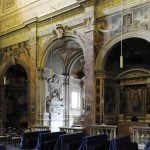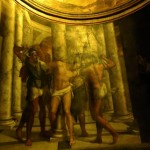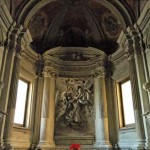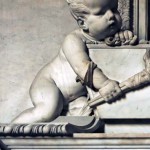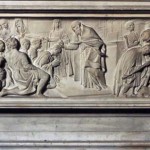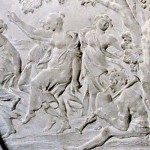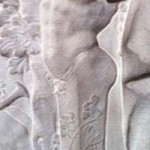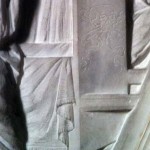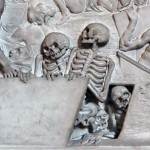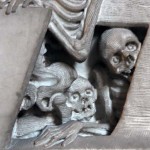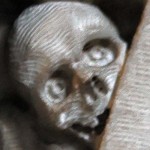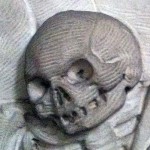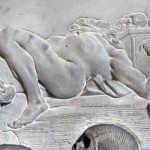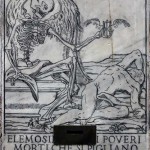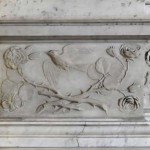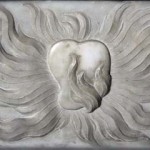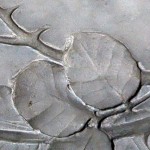Bernini’s Raimondi Chapel in S. Pietro in Montorio, Rome 1638–48
David R. Marshall
The Raimondi chapel in S. Pietro in Montorio is proof of the triumph of sculpture over painting. At 8.30am on a cold winter’s morning, when the church opens, it is the one well-lit part of the church (Fig. 1). Opposite, Sebastiano del Piombo’s Christ at the Column is plunged in gloom, from which it is barely rescued by artificial lighting (Fig. 2). To be sure it is a question of condition, but then the condition of the Raimondi chapel is not great either, with loose pieces of marble lying about, but it does not affect the experience. What stands out is the sarcophagus below the right hand Raimondi (Monsignor Girolamo, died 1628) (Fig. 3). The Bernini conceit of hinging back the top of the sarcophagus (which I am sure were never hinged in this way) (Fig. 4) to reveal the body within gives you a buzz when you recognise the Berninesque active drama that it implies, although given what is on the reliefs it is a bit creepy.
The well-lit relief on the side of the sarcophagus, by Niccolò Sale, shows scenes that, according to Wittkower, have never been satisfactorily explained, but which he suggests represents ‘Carnival, Lent and Death’ (Fig. 5). Unlike Roman sarcophagus reliefs, this is stunningly pictorial, all the way from high relief to the shallowest of incisions, which you can trace with your fingers. On the left are Poussinesque dancing girls (Fig. 6), perhaps symbolising the good life (Poussin’s Dance of Human Life has been proposed as a source). These are overseen by a herm of Pan (Fig. 7), but unlike most of Poussin’s herms, and herms of Pan generally, the torso sticks out on one side and the bottom on the other. On his head is a basket like those born by canephoroi. On the other side a man is being lowered into his grave by a muscular man holding the bundle sheet that supports him as he is lowered (Fig. 8). This feels rather like Guercino’s S. Petronilla.
Further to the right is an intriguing detail. A body has been brought to the grave on a kind of litter (Fig. 9). This litter has beams jutting out at the one visible end for transportation, and a lion’s foot underneath for when it is put down. The end has a shaped top with an incised death-head. The inside is lined with fabric that and spills over the edges. Is it an invention? Is it based on some antique relief one might find by trawling through Montfaucon? Is it based on something that was actually used in the seventeenth century? Curiously, the answer is found not far away, in the Via Giulia. The church of S. Maria dell’Orazione e Morte was the church of a confraternity of that name, who gave decent burials to the dead found abandoned in the fields and streets in and around Rome. Downstairs it has an ossuary, with the bones arranged in decorative and representational patterns, like the better known one in the Capuchin church at the start of Via Vittorio Veneto (Fig. 10). Until recently this has always been closed, but lately the nuns have been encouraging visitors to visit it. And there, sure enough, is a metal cart used to carry the bodies of the dead (Figs. 11). It is clearly old, but whether nineteenth, eighteenth or seventeenth century does not matter much. Functionally, it is clearly the kind of cart that the relief in the Raimondi Chapel alludes to, although the latter is probably made of wood. The lion’s paw need not be fanciful: this was the kind of thing Baroque woodcarver’s did as a matter of course.
The sarcophagus relief, also by Sale, on the tomb on the other side (Monsignor Francesco, died 1338), which does not get direct light in the morning but still easily visible, is more creepy. It shows the Last Judgement, and the sculptor has had a morbid kind of fun in animating the heads of skeletons. A grave slab has been moved aside (it looks at first like a kind of trapezoidal shutter on a wall tomb, but the vestigial perspective indicates that it is intended to be understood as lying flat on the ground) (Fig. 12). Some skeletons have moved it aside to reveal further skeletons peering out (Fig. 13). The sculptor has made the one in the top right expressive of fearfulness, as he looks out on a world scarily different from what he has become accustomed too (Fig. 14). He does this by elongating the eye sockets and putting round forms at the back of the socket, so that it reads as a cartoon-like expression of fearful anticipation. The leftmost skeleton of the two holding the slab, by contrast, looks mischievous in an evil kind of way, a tricksy fellow, like Gollum (Fig. 15). Behind, in wonderful relievo schiacchiato, are the head and shoulders of a man seen from the back, the windswept hair and muscular back and obviously allusion to, and derivation from, the Ignudi of the Sistine Ceiling (Fig. 16). Above him is a (full fleshed) body of a man, in a pose popular at this period: we see the raised left thigh, and sharply foreshortened chest (Fig. 17). This probably has a prime source somewhere; another related example is an incised relief on an alms-box on S. Maria dell Orazione e Morte, where skeletons also come alive (Fig. 18).
The sculptural triumph of the chapel, though, is the frieze of roses below (Fig. 19). This is centred on two flaming hearts (Fig. 20), an image that many non-Catholics find distasteful because of associations with debased devotional art, but if you ignore that and concentrate on the roses it is the naturalism that is most striking. The thorns are realistically spiky, but there is something in the way they and the leaves are rendered in soft planes vividly brings to mind the real thing (Fig. 21), while at the same time softening the sharp pain these thorns would, in reality, have inflicted on your fingers if you had run them over them in the way you have just done on the relief. Such reliefs encourage touch: repeated touching has made shiny one of the little birds that are interspersed with the roses.
(References: Rudolf Wittkower, Bernini: the Sculptor of the Roman Baroque, London: Phaidon, 1997, cat. 46, pp. 263–65.)
- Fig 1 Raimondi Chapel
- Fig 2 Raimondi Chapel
- Fig 3 Raimondi Chapel
- Fig 4 Raimondi Chapel
- Fig 5 Raimondi Chapel
- Fig 6 Raimondi Chapel
- Fig 7 Raimondi Chapel
- Fig 8 Raimondi Chapel
- Fig 9 Raimondi Chapel
- Fig 10 Raimondi Chapel
- Fig 11 Raimondi Chapel
- Fig 12 Raimondi Chapel. Photo by David R. Marshall
- Fig 13 Raimondi Chapel
- Fig 14 Raimondi Chapel
- Fig 15 Raimondi Chapel
- Fig 16 Raimondi Chapel
- Fig 17 Raimondi Chapel
- Fig 18 Raimondi Chapel
- Fig 19 Raimondi Chapel
- Fig 20 Raimondi Chapel
- Fig 21 Raimondi Chapel
© David R. Marshall 2012


